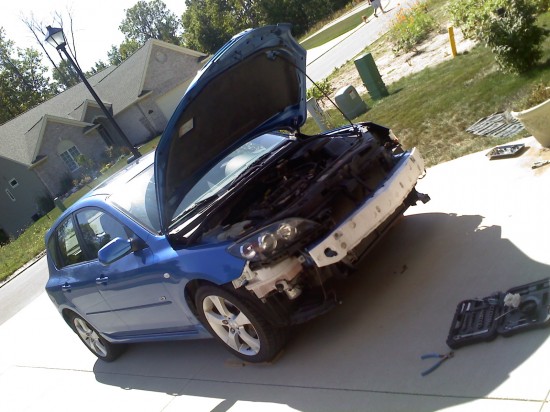The Great Value of Photographs
Post contributed by Dan Baldyga.
You were humming along on a bright and sunny day when suddenly Fred Fuddle, a local character from a nearby town, drunk as a skunk and zooming along in this pickup, flew through stop sign crashing into the right front of your motor vehicle. You had no choice to avoid him. Now the time has come to settle your claim for property damage and personal injuries. Let’s talk about photographs one of the basics that should have been taking place – – just as soon as possible – – after that impact had taken place.
PHOTOGRAPHS OF INJURIES: Photographs are often the best evidence you can produce to increase the value of your claim. If your accident causes bodily injuries that are visible (such as bruises, deep cuts, swellings, lacerations, dislocations and/or black and blue marks) it’s crucial, to the ultimate settlement value of your case, that you have photographs taken of those just as soon as possible! Take them from 3 feet away and also as close as you can so as to capture the seriousness of heir existence. When you hand those to Adjuster I. M. Smart from the Granite Insurance Company believe me when I tell you he’ll stare at them and blanch! QUESTION: “How does Dan know that”? ANSWER: “Because Dan’s been there, felt and done that”!
PHOTOGRAPHS OF BOTH VEHICLES: You should take photographs of the damages to your vehicle from several different angles. If at all possible find the motor vehicle that hit you and take photographs of that damage also. When it comes to proving the impact your body was subjected to (and in many cases to prove who was at fault) those photographs could one day be worth their weight in gold.
HOW TO TAKE PHOTOGRAPHS OF THE ACCIDENT SCENE: The pictures of each accident scene should be taken from at least three different angles: Snap several of a “General View” of the area from about 20 to 40 feet away; a couple more “Medium Range” shot’s from 10 to 15 feet away, and then some “Close Up” shot’s from 3 to 5 feet away. If it’s at all possible all three different distances should have a common point or orientation. If, for example, you’re snapping photographs of a skid mark, it should be taken from an angle so as to clearly show were that skid mark is, in relation to a landmark, like a street sign, a building, a fire hydrant, etc. Another photograph should then be taken with a closer view – – one clearly identifying the skid mark in detail – – and also, if possible, include this readily identifiable object or landmark (the street signs, building‘s, etc.).
Because they’re such potent evidence you should blow up those photographs of the skid marks, taken from 3 to 6 feet away, into 8X10 glossies. A total of 12 to 15 photographs of the accident scene and/or the skid marks are not too many. When you hand copies of the 8X10 glossy photograph’s of those skid marks to the adjuster, to help justify the payment he’ll eventually make to you, it will absolutely increase the value of your claim. Why? Because it will tell both adjuster Smart and his supervisor (who, in the end, will usually call the shots on how much your settlement dollars should be) that you know what you’re doing and you’re not the type of individual who can be taken advantage of.
A WORD OF CAUTION: The individual engaged in the task of snapping photograph’s of your body, the accident scene, etc., should be careful to make sure they’re not undertaking this effort with a casual, hasty or careless attitude – – one that tends to leave it up to do the camera to do the thinking for them. Rather, the photographer ought to carefully consider the process and execute it very seriously so that the photos produced will produce the maximum value.
If at all possible photos should be taken of the exact location on the road where the impact occurred, and shots of all relevant gouge and/or chop marks on the surface, plus traffic signs, etc., as applicable.
It cannot be emphasized enough that photographs of skid marks are invaluable evidence, since they can often indicate Fuddle’s speed at the time of impact and can be a tremendous asset when it comes to establishing fault.
A good practice to follow is to make a brief notation on the backs of all photos, entering upon them a brief account of what or whom the photo is showing, the date it was taken and by whom.
Photographs of injuries, the accident scene and the road surface if done correctly, is money in the bank!
DISCLAIMER: The only purpose of this claim tip is to help people understand the motor vehicle accident claim process. Neither Dan Baldyga nor Automotive Trends make any guarantee of any kind whatsoever; NOR to substitute for a lawyer, an insurance adjuster, or claims consultant, or the like. Where such professional help is desired it is the INDIVIDUAL’S RESPONSIBILITY to obtain said services.
Dan Baldyga’s latest book AUTO ACCIDENT PERSONAL INJURY INSURANCE CLAIM (How To Evaluate And Settle Your Loss) can be found on the internet at his web site http://www.autoaccidentclaims.com. This book reveals “How To” successfully handle your motor vehicle accident claim, so you won’t be taken advantage of. It also goes into detail regarding the revolutionary BASE (The Baldyga Auto Accident Settlement Evaluation Formula). BASE will explain how to determine the value of the “Pain and Suffering” you endured, because of your personal injury.







